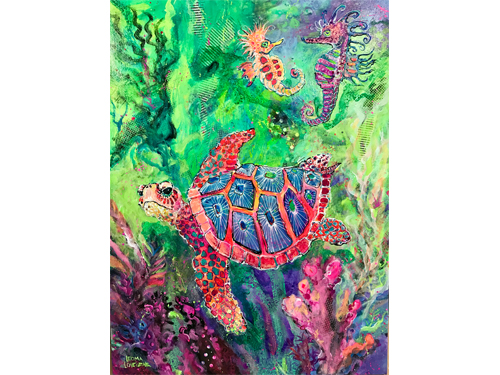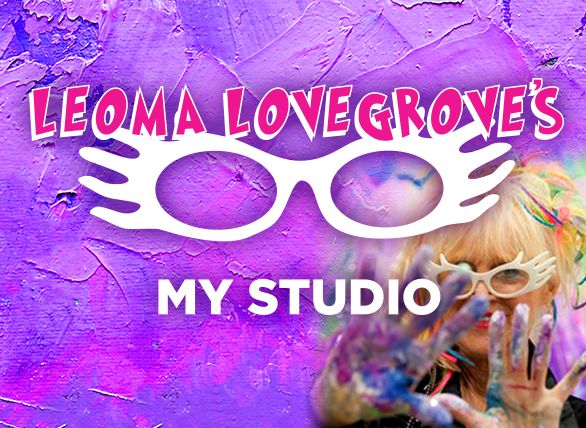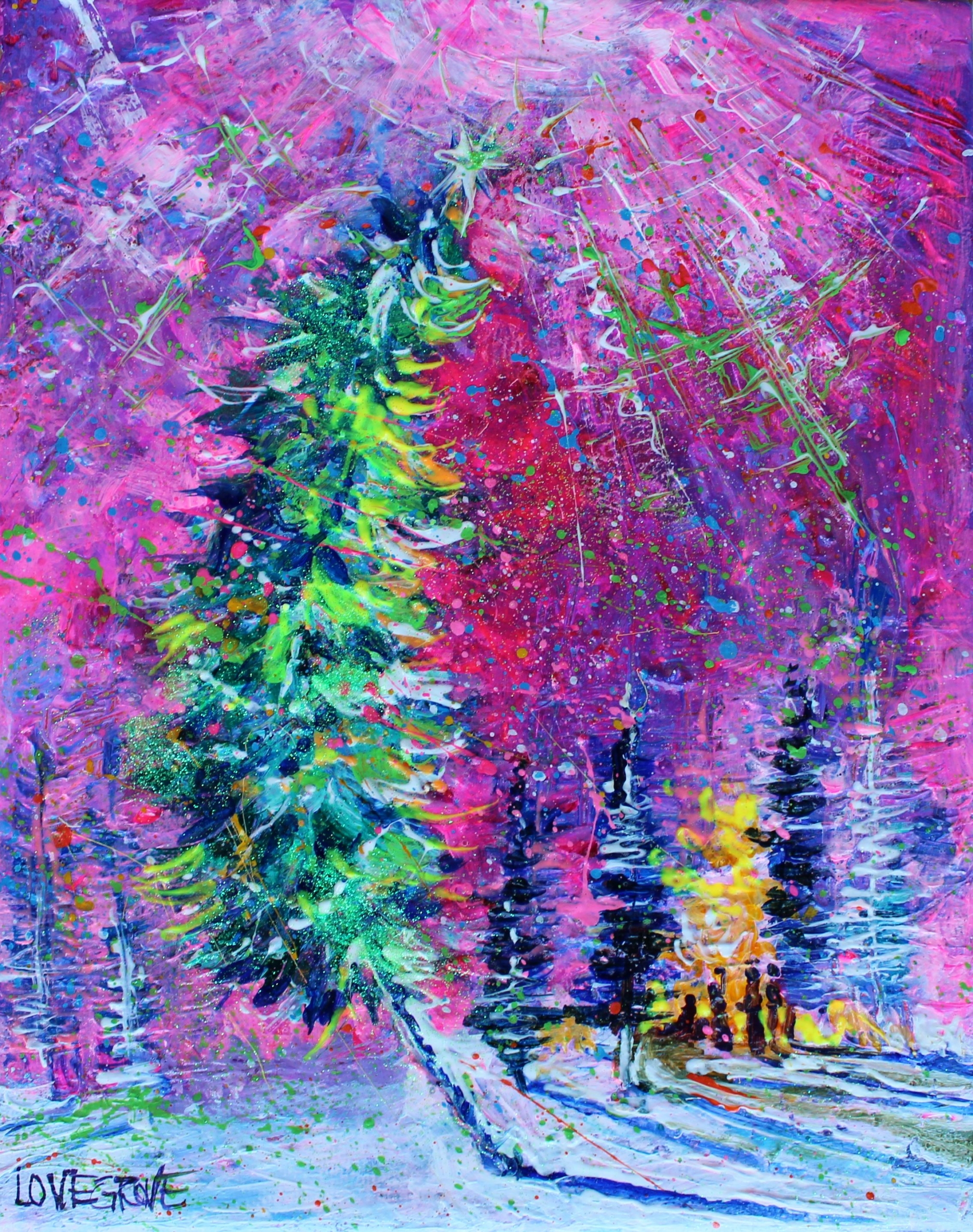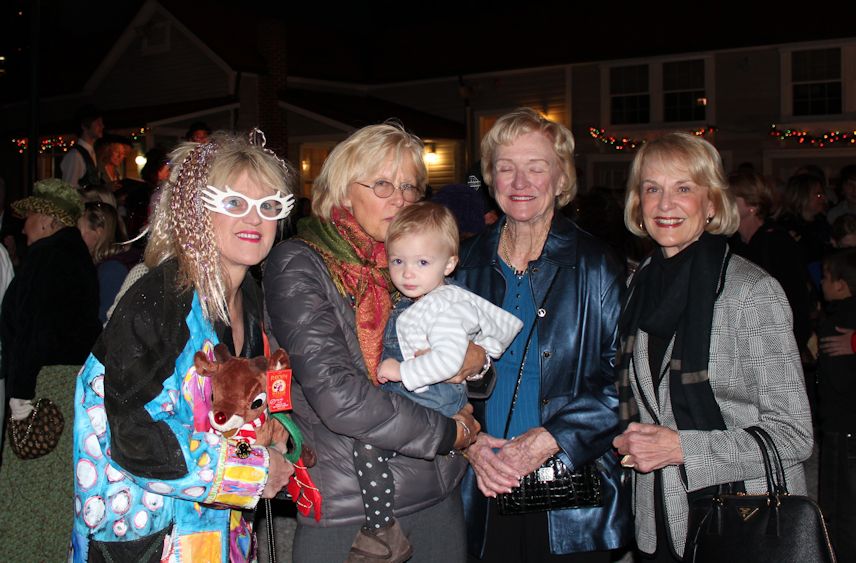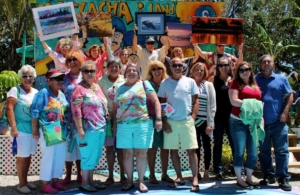 Yesterday, we celebrated Slow Art Day here at Lovegrove Gallery & Gardens. Although it is a worldwide event, there were only ten locations in all of Florida that observed Slow Art Day, and we were the only one south of Sarasota and east of Miami and West Palm Beach!
Yesterday, we celebrated Slow Art Day here at Lovegrove Gallery & Gardens. Although it is a worldwide event, there were only ten locations in all of Florida that observed Slow Art Day, and we were the only one south of Sarasota and east of Miami and West Palm Beach!
Over a leisurely lunch catered by Bubba’s Roadhouse, some three dozen Slow Art participants discussed artworks created by me, Bob Phillips, Rick Webber, Wanda Extrom, Kirsten Troyer and 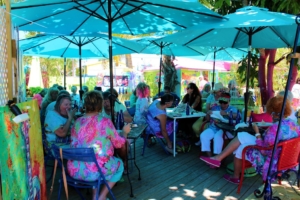 Emma Troyer. What they had to say was as instructional for the participating artists as it was for each of the spectators, and it bore out something I’ve been telling people for a very long time. You don’t have to be educated in art to appreciate a painting, a sculpture or a photograph. There’s just two things you have to know: either you like it or you don’t; either it means something to you or it doesn’t.
Emma Troyer. What they had to say was as instructional for the participating artists as it was for each of the spectators, and it bore out something I’ve been telling people for a very long time. You don’t have to be educated in art to appreciate a painting, a sculpture or a photograph. There’s just two things you have to know: either you like it or you don’t; either it means something to you or it doesn’t.
While you aren’t going to love every artwork, you will 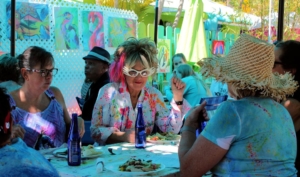 usually find something in an exhibition that you will connect with. And it’s not the artist’s technique or the work’s significance within the broader context of recent trends or art history. Most people connect with a work of art for one of four reasons: it evokes and emotion, triggers a memory, shows them something totally unexpected or unusual, or they fall in love with the story behind the work.
usually find something in an exhibition that you will connect with. And it’s not the artist’s technique or the work’s significance within the broader context of recent trends or art history. Most people connect with a work of art for one of four reasons: it evokes and emotion, triggers a memory, shows them something totally unexpected or unusual, or they fall in love with the story behind the work.
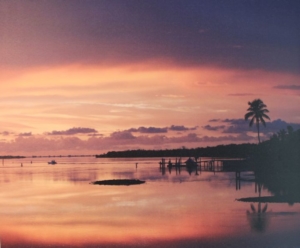 For example, one of the artworks that we looked at yesterday was a purple sunset and another was a bright orange sunrise. As we went around the cerulean blue umbrelled tables, here’s the observations our Slow Art Day participants shared with the group: “serene,” “restful,” “relaxing,” “made me feel like I was sitting there unwinding at the end of the day with a glass of wine,” “serene,” “peaceful,” “soothing,” “calming,” and “gave me a sense of excitement that comes with the dawning of a new day.
For example, one of the artworks that we looked at yesterday was a purple sunset and another was a bright orange sunrise. As we went around the cerulean blue umbrelled tables, here’s the observations our Slow Art Day participants shared with the group: “serene,” “restful,” “relaxing,” “made me feel like I was sitting there unwinding at the end of the day with a glass of wine,” “serene,” “peaceful,” “soothing,” “calming,” and “gave me a sense of excitement that comes with the dawning of a new day.
By contrast, when the artists took their turn at bat, we talked about concepts 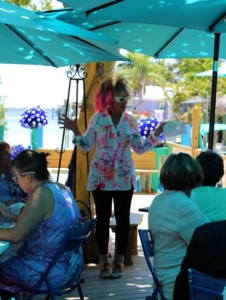 like “the rule of thirds,” the absence of straight lines and the type of lens used to capture the image. And while we may have enlightened the non-artists in the group and enhanced their overall understanding of what the photographer considered when framing the picture in the viewfinder, it in no way diminished their enjoyment of the image or invalidated their individual reaction to what they’d seen and experienced.
like “the rule of thirds,” the absence of straight lines and the type of lens used to capture the image. And while we may have enlightened the non-artists in the group and enhanced their overall understanding of what the photographer considered when framing the picture in the viewfinder, it in no way diminished their enjoyment of the image or invalidated their individual reaction to what they’d seen and experienced.
Another jumping off point for people when they look at art is a memory or memory fragment of some person, place or experience. A lot of the people who participated in Slow Art Day remarked that they liked a particular image because it reminded them of a place they’d visited on vacation, the palm trees they’d admired on past trips to 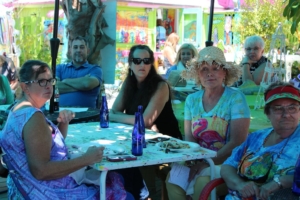 Matlacha or Sanibel Island, or a place that had been important to them growing up as a child. It’s almost as if the mind searches for points of similitude or familiarity. If the memory is a good one, the viewer’s impression of the piece is likely to be favorable, as well.
Matlacha or Sanibel Island, or a place that had been important to them growing up as a child. It’s almost as if the mind searches for points of similitude or familiarity. If the memory is a good one, the viewer’s impression of the piece is likely to be favorable, as well.
Bob Phillips took a photograph he called Matlacha Reflections. While everyone loved the bright orange of the sky, the silhouettes of the palms and island and the warmth of the rising 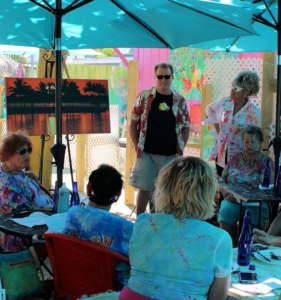 sun, the image took on added significance for me and everyone else after Bob and Wanda Extrom pointed out that since he took the picture, a large house has been built that now blocks the view, making Matlacha Reflections a one-of-a-kind scene.
sun, the image took on added significance for me and everyone else after Bob and Wanda Extrom pointed out that since he took the picture, a large house has been built that now blocks the view, making Matlacha Reflections a one-of-a-kind scene.
That was also at play, in part, in Rick Webber’s photograph titled Greta in Flight. Wanda is a heron, and everyone at yesterday’s Slow Art Day were astounded by the accuracy, detail and color Rick managed to capture in his photograph of the bird in flight. They were even more impressed when Rick told us that he’s known Greta for quite some time, and on the day he took her picture in flight, she’d let him get as close as ten or fifteen feet away, a 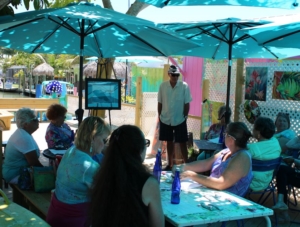 vantage he’d gladly occupied for nearly half an hour before the heron got bored – or hungry – and decided to fly away. “I was lucky,” Rick demurred. “If she hadn’t let me get that close and hadn’t gotten fidgety, I’d have never been ready to take the shot just as she took flight.”
vantage he’d gladly occupied for nearly half an hour before the heron got bored – or hungry – and decided to fly away. “I was lucky,” Rick demurred. “If she hadn’t let me get that close and hadn’t gotten fidgety, I’d have never been ready to take the shot just as she took flight.”
And that checked off another box on the list of reasons people find resonance with a given work of art. Rick’s shot was unusual. It was different and unexpected, in a totally good kind of way.
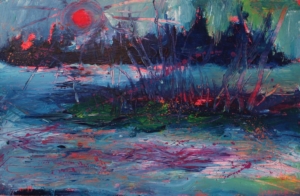 Of course, not every different or unusual prompts a favorable reaction. And so it was with my own contribution to Slow Art Day. It’s a painting I rendered in all of eight minutes while I was painting aboard an exact replica of Claude Monet’s floating studio Le Bateau-Atelier that Captain Bertrand de Vautibault had built in order to allow painters like myself to sail the Seine in search of the best scenery, just as Monet did more than 140 years ago.
Of course, not every different or unusual prompts a favorable reaction. And so it was with my own contribution to Slow Art Day. It’s a painting I rendered in all of eight minutes while I was painting aboard an exact replica of Claude Monet’s floating studio Le Bateau-Atelier that Captain Bertrand de Vautibault had built in order to allow painters like myself to sail the Seine in search of the best scenery, just as Monet did more than 140 years ago.
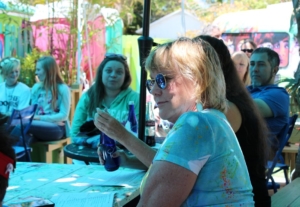 It was interesting. While complimentary, pretty much everyone expressed surprise over the fact that the painting lacked my customary palette of vibrantly colorful pigments and hues. “I was shocked that it’s so dark,” remarked one of the participants, “although that makes the orange of the sun jump out even more.”
It was interesting. While complimentary, pretty much everyone expressed surprise over the fact that the painting lacked my customary palette of vibrantly colorful pigments and hues. “I was shocked that it’s so dark,” remarked one of the participants, “although that makes the orange of the sun jump out even more.”
I’ll admit, I enjoyed the fact that everyone seemed more than a little put off by the lack of vibrant color in the painting. 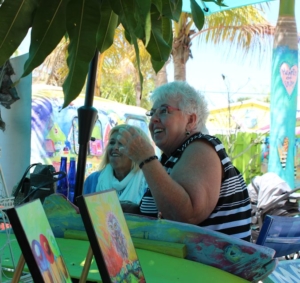 “I was actually taken aback,” said one of my fans, who was sporting one of my designs that she’d purchased at Bealls.
“I was actually taken aback,” said one of my fans, who was sporting one of my designs that she’d purchased at Bealls.
“What I like is the fact that there’s a splash of red on the side of the tree away from the sun, which is the opposite of where you’d expect to find it.” I told him that’s because Impressionists don’t believe in shadows. Dark shadows of the kind that masters like Leonard da Vinci and Rembrant used do not occur in sunlight or open air. That’s why Impressionists traditionally blur the outlines of shapes and objects, as I did in First Son Light.
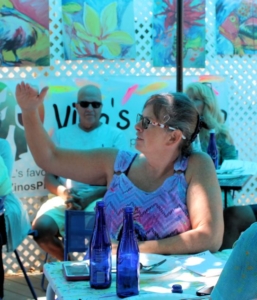 But that was only part of the explanation, as my friend and art journalist Tom Hall pointed out after everyone had left.
But that was only part of the explanation, as my friend and art journalist Tom Hall pointed out after everyone had left.
“You did something few artists and only a handful of Impressionists would dare try in a two-dimensional painting,” said Tom. “You didn’t just paint your impression of what you saw along the banks of the Seine as your boat sailed quietly by. You painted an impression of motion itself. Your painting captures the fleeting impression of shape, form and color as influenced by movement. That’s an added dimension that’s rarely attempted, and no one knew what to make of it because it’s something completely out of their experience.”
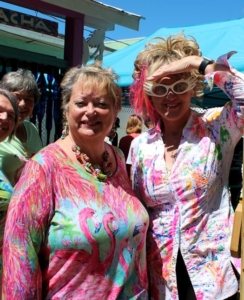 Although that had not even occurred to me at the time, Tom’s absolutely right. An Impressionist trains their eye to take in a scene almost peripherally. That’s because the eye can only focus on one tiny little spot. But tied as it is to our brains, the human eye is an intriguing little instrument. You need give it only the slightest of hints, and it builds up in the brain the rest of the scene that it knows to be there from past experience.
Although that had not even occurred to me at the time, Tom’s absolutely right. An Impressionist trains their eye to take in a scene almost peripherally. That’s because the eye can only focus on one tiny little spot. But tied as it is to our brains, the human eye is an intriguing little instrument. You need give it only the slightest of hints, and it builds up in the brain the rest of the scene that it knows to be there from past experience.
Tom reminded me of a lithograph that Edouard Manet did called The races at Longchamp. At first blush, it looks like little more than a confused scrawl. But through that jumble of raw marks that Manet made on the stone he used for his prints, he knew our brains would glean impressions of light, movement and speed emerging 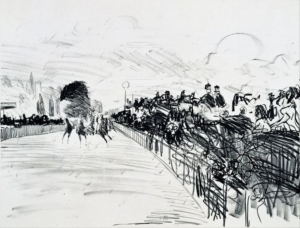 out of the confusion. None of the horses in Manet’s race has four legs. Why? Because we simply wouldn’t see four distinct legs during a momentary glance at such as scene any more than we can differentiate the faces of the spectators or the details of what they’re wearing (the so-called trees from the forest).
out of the confusion. None of the horses in Manet’s race has four legs. Why? Because we simply wouldn’t see four distinct legs during a momentary glance at such as scene any more than we can differentiate the faces of the spectators or the details of what they’re wearing (the so-called trees from the forest).
But unlike The races at Longchamp, where Manet was stationary and the horses and crowd were infused with movement, in my painting, I was the one moving across a 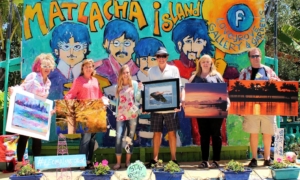 stationary landscape. A subtle difference, perhaps, but akin to the experience we’ve all had looking out the passenger window of a car as the scenery races by.
stationary landscape. A subtle difference, perhaps, but akin to the experience we’ve all had looking out the passenger window of a car as the scenery races by.
“Every other artwork that was viewed during Slow Art Day depicted a static scene,” Tom went on. “Even in Rick Webber’s shot of Greta in flight, he froze the bird in a nanosecond in time. While Emma Troyer’s installation as a 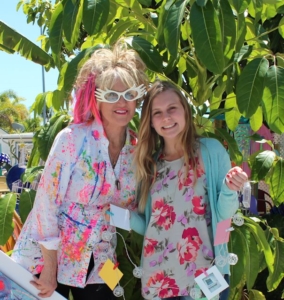 whole, provides a timeline, it too consists of static images strung together to suggest a chronology. But you actually conjure the motion of land, trees and water in a two-dimensional image. No wonder everyone was more than a little confused and disoriented.”
whole, provides a timeline, it too consists of static images strung together to suggest a chronology. But you actually conjure the motion of land, trees and water in a two-dimensional image. No wonder everyone was more than a little confused and disoriented.”
And that is the real power associated with Slow Art Day. We all learn something, lay and professionals, newbies and collectors, painters and photographers.
If you missed Slow Art Day this year, don’t make that mistake again. Mark your calendar for next April. Lovegrove Gallery & Gardens will be participating once again.
______________________________________________________________________
More on photographer Bob Phillips
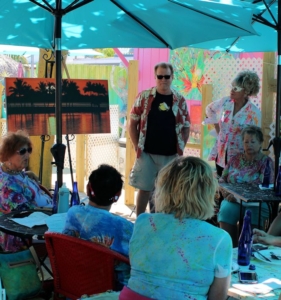 Bob Phillips was also on hand for our observance of Slow Art Day earlier this month. If you’re not familiar with Bob, don’t stress. I wasn’t either until one day when I was painting the mural on the east façade of the Matlacha Post Office. I was up on the scaffold, painting away in my signature hybrid Expressionist/Impressionist style and I hear someone calling my name. I looked around and didn’t see anyone. Then this voice comes wafting off the water. “Here, in the mangroves. It’s Bob Phillips. Your assistant said you wouldn’t mind if I took some pictures of you while you’re working on the mural.”
Bob Phillips was also on hand for our observance of Slow Art Day earlier this month. If you’re not familiar with Bob, don’t stress. I wasn’t either until one day when I was painting the mural on the east façade of the Matlacha Post Office. I was up on the scaffold, painting away in my signature hybrid Expressionist/Impressionist style and I hear someone calling my name. I looked around and didn’t see anyone. Then this voice comes wafting off the water. “Here, in the mangroves. It’s Bob Phillips. Your assistant said you wouldn’t mind if I took some pictures of you while you’re working on the mural.”
True enough, Bob was in the mangroves on the water’s edge. Bob has a reputation for going wherever and whenever he needs to be there to get that perfect digital image.
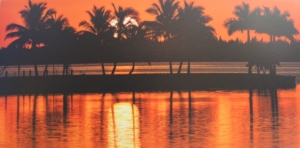 Bob calls the photograph he brought for Slow Art Day Matlacha Reflections. While everyone loved the bright orange of the sky, the silhouettes of the palms and island and the warmth of the rising sun, the image took on added significance for me and everyone else after Bob and Wanda Extrom pointed out that since he took the picture, a large house has been built that now blocks the view, making
Bob calls the photograph he brought for Slow Art Day Matlacha Reflections. While everyone loved the bright orange of the sky, the silhouettes of the palms and island and the warmth of the rising sun, the image took on added significance for me and everyone else after Bob and Wanda Extrom pointed out that since he took the picture, a large house has been built that now blocks the view, making  Matlacha Reflections a one-of-a-kind scene.Wanda Extrom (Photographer) -Is as passionate about being outdoors as she is about photography. Currently she is sharing the beauty of Florida through her landscape and shore bird photos.Bob Bob Bob
Matlacha Reflections a one-of-a-kind scene.Wanda Extrom (Photographer) -Is as passionate about being outdoors as she is about photography. Currently she is sharing the beauty of Florida through her landscape and shore bird photos.Bob Bob Bob
The image didn’t happen by chance. Bob has an app on his phone that tells him where the sun will rise and set, so you can go straight to that spot. This spot is just before Sandy Hook, which is the last bridge as you’re leaving Matlacha and crossing over onto Pine Island. So he got up extra early and was on the bridge, in perfect position to capture the shot just as the sun started carving its arc into the Southwest Florida sky.
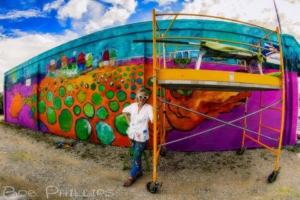 “I’m a big fan of silhouettes,” Bob told everyone on Slow Art Day. “It did everything that I wanted.”
“I’m a big fan of silhouettes,” Bob told everyone on Slow Art Day. “It did everything that I wanted.”
Bob’s also a gifted sports photographer. You should see his shots of the 2017 Daytona 200 motorcycle races and the 2017 Arcadia rodeo. But Matlacha and Bokeela Back Bay are his favorites for sunsets and wildlife images, especially our osprey, egrets and dolphins. He has a whole series called The Forgotten Coast of Florida that is absolutely breathtaking.
So if you get a chance to see Bob’s work or meet him, do so! He’s a terrific, tremendous guy.
______________________________________
Meet Slow Art Day photographer Kirsten Troyer
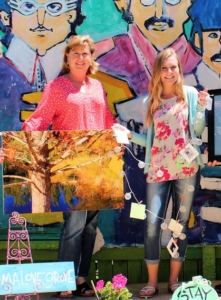 Kirsten Troyer is my staff photographer, and she helps me out on special occasions. I especially call on her when I need that something extra. That’s because Kirsten has a knack for capturing the essence of the moment in her images. She was one of the artists who participated in Lovegrove Gallery & Gardens’ observance of Slow Art Day earlier this month.
Kirsten Troyer is my staff photographer, and she helps me out on special occasions. I especially call on her when I need that something extra. That’s because Kirsten has a knack for capturing the essence of the moment in her images. She was one of the artists who participated in Lovegrove Gallery & Gardens’ observance of Slow Art Day earlier this month.
Photography has been Kirsten’s passion since she was very young. She says that she enjoys framing the beauty of nature and capturing those treasured moments that slip by so quickly.
“I decided to start my business after staying home to raise my three children and being an advocate for my son with Autism,” Kirsten shares.
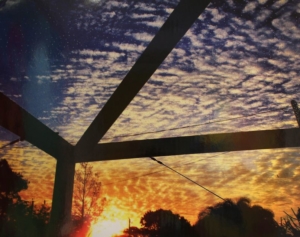 Kirsten specializes in children and family portraits, as well as events, parties, sports photography, engagments, maternity and senior portraits.
Kirsten specializes in children and family portraits, as well as events, parties, sports photography, engagments, maternity and senior portraits.
“I also have a passion for children with Special Needs and providing those families with comfortable and stress free opportunities to get their family portraits as well,” Kirsten amplifies. “Having a son with Autism, I know how difficult it can be to have family pictures taken and I am here to make that as easy as possible. My sessions are done outside at our numerous beautiful Southwest Florida locations or at 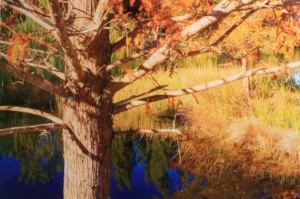 your home.”
your home.”
Kirsten’s photography has been featured on the cover of Studios Magazine and Gulf & Main, and she’s enjoyed a two-page spread in Gulf Shore Life.
The two images she brought for Slow Art Day were a hit. One image depicted a spectacular Southwest Florida sunset … but what made it interesting was that she shot it through her pool 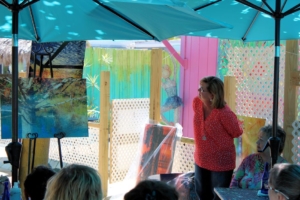 cage. Notice how the angles of the pool cage draw you right into the image!
cage. Notice how the angles of the pool cage draw you right into the image!
The other is more subtle and abstruse. It’s actually a picture of a reflection, but you only see what’s reflected in the water and not the object itself. Also notice the owl in the picture’s upper left corner.
Kirsten’s daughter, Emma, just won the District 19 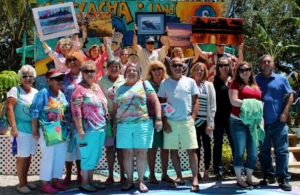 Congressional high school art contest, and her mixed media work is going to be displayed for an entire year in the U.S. Capitol Tunnel along with work by the winners of the art contests held in the other Congressional districts throughout the United States. I’m sure Kirsten is very proud. She also gets to accompany her daughter to Washington D.C. in June for the opening reception. You can read more about that here.
Congressional high school art contest, and her mixed media work is going to be displayed for an entire year in the U.S. Capitol Tunnel along with work by the winners of the art contests held in the other Congressional districts throughout the United States. I’m sure Kirsten is very proud. She also gets to accompany her daughter to Washington D.C. in June for the opening reception. You can read more about that here.
____________________________________________________
Meet Slow Art Day photographer Wanda Extrom
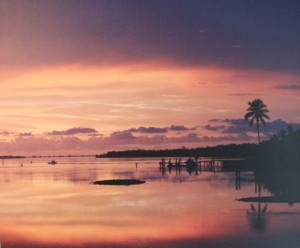 Before I digressed to tell you about the District 19 Congressional Artistic Discovery Contest I helped judge with Mercedes Price and Christi Marcoplos, I was sharing some info and insights about the artists who participated in Slow Art Day. Another of the artists on hand here at Lovegrove Gallery & Gardens was Wanda Extrom, whose photograph Purple Glass was a big hit.
Before I digressed to tell you about the District 19 Congressional Artistic Discovery Contest I helped judge with Mercedes Price and Christi Marcoplos, I was sharing some info and insights about the artists who participated in Slow Art Day. Another of the artists on hand here at Lovegrove Gallery & Gardens was Wanda Extrom, whose photograph Purple Glass was a big hit.
Participants called the image “serene,” “restful,” “relaxing,” “peaceful,” “soothing, and “calming.” One person said it “made me feel like I was sitting there unwinding at the end of the day with a 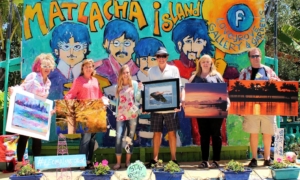 glass of wine.” Karen Jarstad said, “It has a gauzy effect and the longer I looked at it, it made me feel like I was sitting on a beach with my eyes sort of half closed in that nether place between sleep and wakefulness.”
glass of wine.” Karen Jarstad said, “It has a gauzy effect and the longer I looked at it, it made me feel like I was sitting on a beach with my eyes sort of half closed in that nether place between sleep and wakefulness.”
This was music to Wanda’s ears because every artist wants to foster these types of reactions in the people who view their work. It almost justifies the rigors of a shoot like that. “The worst thing about that night was the no-see-ems.”
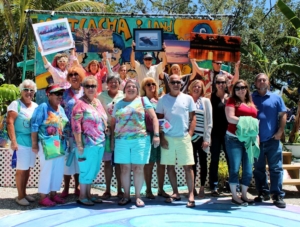 Wanda is as passionate about being outdoors as she is about photography. Currently she is sharing the beauty of Florida through her landscape and shore bird photos. While she snaps images of birds wherever she finds them, she likes nothing better than photographing birds at rookeries, like those at the St. Augustine Alligator Farm and Gatorland in Orlando. The reason: she can not only capture images of birds displaying their breeding plumage and building nests, but can even spot females sitting on eggs and caring for their chicks. A good telephoto lens is indispensable to get the best shot.
Wanda is as passionate about being outdoors as she is about photography. Currently she is sharing the beauty of Florida through her landscape and shore bird photos. While she snaps images of birds wherever she finds them, she likes nothing better than photographing birds at rookeries, like those at the St. Augustine Alligator Farm and Gatorland in Orlando. The reason: she can not only capture images of birds displaying their breeding plumage and building nests, but can even spot females sitting on eggs and caring for their chicks. A good telephoto lens is indispensable to get the best shot.
_______________________________________________________
Meet author and photographer Rick Weber
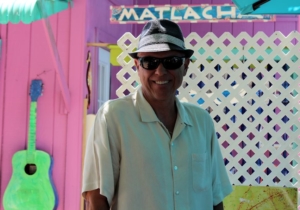 For this year’s celebration of Slow Art Day at Lovegrove Gallery & Gardens photographer and author Rick Weber brought a stunning wildlife image called Greta in Flight. Wildlife and sunsets are his passion.
For this year’s celebration of Slow Art Day at Lovegrove Gallery & Gardens photographer and author Rick Weber brought a stunning wildlife image called Greta in Flight. Wildlife and sunsets are his passion.
“I’ve always felt an undeniable attraction for the ocean, especially at sunset. And especially at low tide,” says Rick. “The colors come alive. The calm sheet of water serves as a mirror of oranges, pinks and purples. The ibises, herons and seagulls seem a little more relaxed, 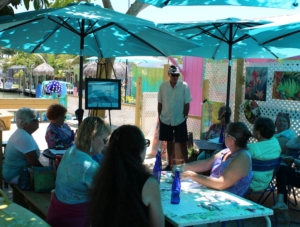 allowing me to penetrate their comfort zone. This is where I go to fill my soul. The perfect ending to any day.”
allowing me to penetrate their comfort zone. This is where I go to fill my soul. The perfect ending to any day.”
One of the herons who periodically tolerates Rick’s presence in their comfort zone is Greta, a stately bird that frequents Bunch Beach out in Punta Rassa (on the Fort Myers side of the Sanibel Causeway). One day Greta allowed Rick to occupy a piece of sand just ten or so feet away from her – for nearly 30 glorious minutes. “Then she got tired of me and decided to take flight. Fortunately, I noticed her 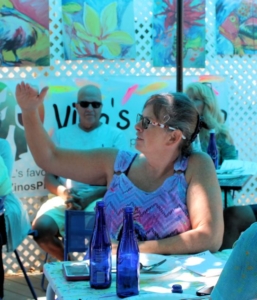 getting fidgety, which gave me just the head’s up I needed to get my camera ready. I was lucky. I took four shots, just hoping one would be in focus and in frame. All four were. This one’s the best.”
getting fidgety, which gave me just the head’s up I needed to get my camera ready. I was lucky. I took four shots, just hoping one would be in focus and in frame. All four were. This one’s the best.”
During Slow Art Day, the participants all marveled over the detail that Rick managed to capture in his shot, not to mention the colors in Greta’s head, beak and eye. “It was sunset, and the light caught her just right,” Rick explained. It takes a special talent and a really good lens to freeze-frame a bird in flight, so kudos to Rick on both counts.
Although Rick is humble and self-deprecating, the truth is that Greta was no happy accident. In fact, Rick’s an illustration of my favorite d efinition of luck – which is preparation meeting opportunity. One of his photographs, a stunning, evocative sunset, took first place in the 2014 Audubon Society, and his close-up of a fiddler crab took third. He won two more awards in 2017 for scenery and plants. His photos have been published in the Los Angeles Times and numerous magazines.
efinition of luck – which is preparation meeting opportunity. One of his photographs, a stunning, evocative sunset, took first place in the 2014 Audubon Society, and his close-up of a fiddler crab took third. He won two more awards in 2017 for scenery and plants. His photos have been published in the Los Angeles Times and numerous magazines.
As the folks attending Slow Art Day learned, Rick is also an accomplished author. He wrote Pink Lips and Fingertips, and made contributions to three Chicken Soup for the Soul books. He has won the Casey Medal for Meritorious Journalism, been honored twice by the Associated Press Sports Editors for  column writing and feature writing, and won numerous state awards.
column writing and feature writing, and won numerous state awards.
We were honored and lucky to have Rick join us for Slow Art Day 2017.
[P.S. Rick divulged during Slow Art Day that he names every heron he encounters Greta. It’s an anagram for “great,” quips Rick, “and a beautiful piece of alliteration.” But more, great blue herons 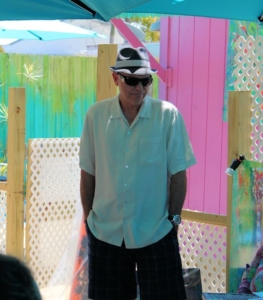 seem to Rick like the animal kingdom’s equivalent of “exquisite, mysterious Swedish actress Greta Garbo.” Rick tells a wonderful story about another Greta, one who hangs out in his backyard, in his blog. Here’s the link. Rick’s account of backyard Greta will give you a bird’s eye view of his writing style and mental make-up. It’s well worth the time.]
seem to Rick like the animal kingdom’s equivalent of “exquisite, mysterious Swedish actress Greta Garbo.” Rick tells a wonderful story about another Greta, one who hangs out in his backyard, in his blog. Here’s the link. Rick’s account of backyard Greta will give you a bird’s eye view of his writing style and mental make-up. It’s well worth the time.]
